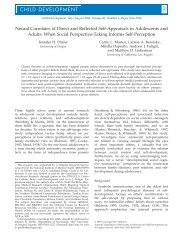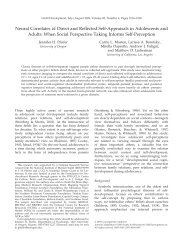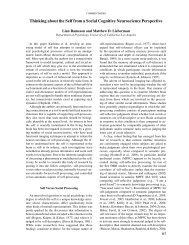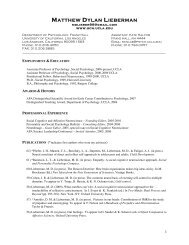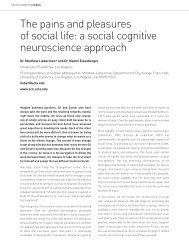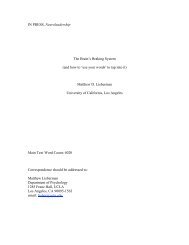In Progress – DO NOT CITE Attributional inference across cultures ...
In Progress – DO NOT CITE Attributional inference across cultures ...
In Progress – DO NOT CITE Attributional inference across cultures ...
You also want an ePaper? Increase the reach of your titles
YUMPU automatically turns print PDFs into web optimized ePapers that Google loves.
Culture, Attribution, & Automaticity<br />
4<br />
habitual <strong>inference</strong>, and a theory-driven correction, can be set in motion depending on the<br />
inferential goal (see Figure 1). The D-sequence occurs when a dispositional <strong>inference</strong><br />
goal is present (“Is this woman anxious in general”) such that the habitual <strong>inference</strong> is<br />
an automatic attribution of observed behavior to the target’s disposition, resulting in the<br />
correspondence bias. If consciously controlled processing resources are available, and<br />
the observer is motivated, the initial attribution will be corrected according to an<br />
attributional theory of situational constraints on behavior (Gilbert, Pelham, & Krull,<br />
1988). The D-sequence presupposes that people possess an attributional theory of<br />
situational factors such that the presence of situational factors promoting the observed<br />
behavior indicate that the dispositional cause should be discounted. Thus, during D-<br />
sequence discounting, perceivers would correct their initial attribution to make a weaker<br />
dispositional attribution. Alternatively, situational factors inhibiting an observed<br />
behavior indicate that the dispositional cause should be augmented. During D-sequence<br />
augmenting, perceivers would correct their initial attribution to make a stronger<br />
dispositional attribution.<br />
<strong>In</strong> contrast to the D-sequence, the S-sequence occurs when a situational <strong>inference</strong><br />
goal is present (“Is this woman in an anxiety-provoking situation”) such that the habitual<br />
<strong>inference</strong> is an automatic attribution of observed behavior to the target’s situations (Krull,<br />
1993). This initial attribution will be updated to take dispositional information into<br />
account if controlled processing resources and motivation are present. The S-sequence<br />
presupposes that people possess an attributional theory of dispositional factors such that<br />
the presence of factors promoting the observed behavior indicate that the situational<br />
cause should be discounted. Thus, during S-sequence discounting, perceivers would



